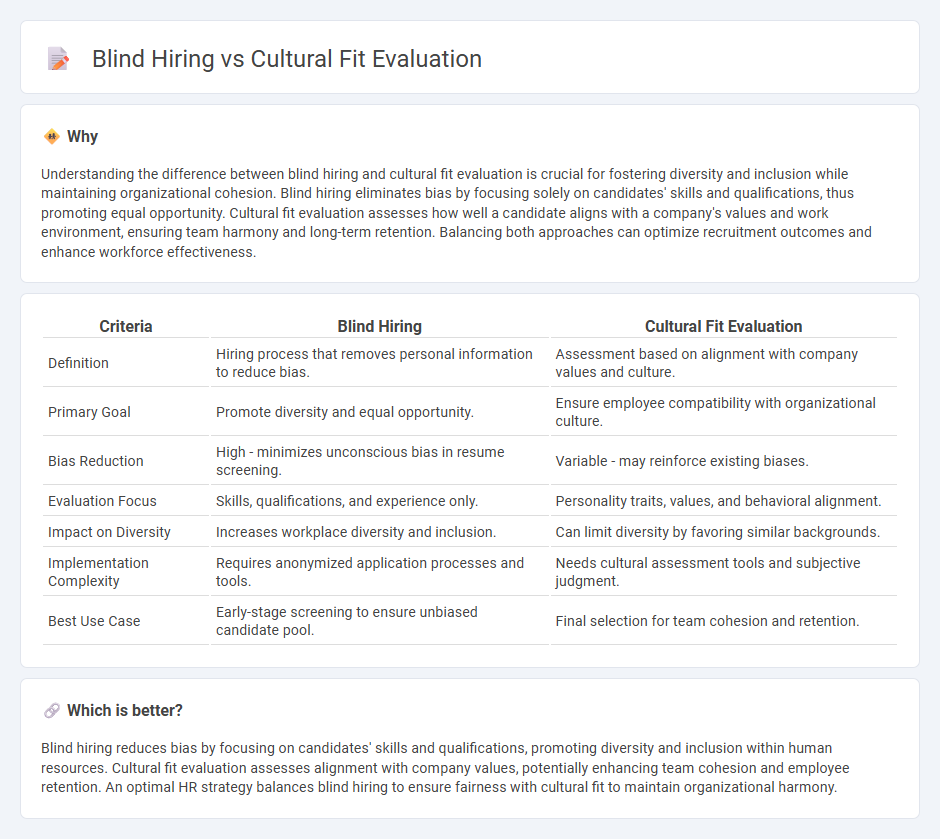
Blind hiring removes personal identifiers from resumes to minimize unconscious bias and promote diversity in recruitment. Cultural fit evaluation assesses alignment between a candidate's values and company culture, aiming to enhance team cohesion and long-term retention. Discover more about balancing objectivity and compatibility in hiring practices.
Why it is important
Understanding the difference between blind hiring and cultural fit evaluation is crucial for fostering diversity and inclusion while maintaining organizational cohesion. Blind hiring eliminates bias by focusing solely on candidates' skills and qualifications, thus promoting equal opportunity. Cultural fit evaluation assesses how well a candidate aligns with a company's values and work environment, ensuring team harmony and long-term retention. Balancing both approaches can optimize recruitment outcomes and enhance workforce effectiveness.
Comparison Table
| Criteria | Blind Hiring | Cultural Fit Evaluation |
|---|---|---|
| Definition | Hiring process that removes personal information to reduce bias. | Assessment based on alignment with company values and culture. |
| Primary Goal | Promote diversity and equal opportunity. | Ensure employee compatibility with organizational culture. |
| Bias Reduction | High - minimizes unconscious bias in resume screening. | Variable - may reinforce existing biases. |
| Evaluation Focus | Skills, qualifications, and experience only. | Personality traits, values, and behavioral alignment. |
| Impact on Diversity | Increases workplace diversity and inclusion. | Can limit diversity by favoring similar backgrounds. |
| Implementation Complexity | Requires anonymized application processes and tools. | Needs cultural assessment tools and subjective judgment. |
| Best Use Case | Early-stage screening to ensure unbiased candidate pool. | Final selection for team cohesion and retention. |
Which is better?
Blind hiring reduces bias by focusing on candidates' skills and qualifications, promoting diversity and inclusion within human resources. Cultural fit evaluation assesses alignment with company values, potentially enhancing team cohesion and employee retention. An optimal HR strategy balances blind hiring to ensure fairness with cultural fit to maintain organizational harmony.
Connection
Blind hiring minimizes unconscious bias by removing demographic information from resumes, fostering a diverse talent pool crucial for effective cultural fit evaluation. Evaluating cultural fit post-blind hiring ensures that candidates not only possess the right skills but also align with the organization's values and work environment. This combined approach enhances employee retention and drives inclusive workplace culture development.
Key Terms
**Cultural Fit Evaluation:**
Cultural fit evaluation assesses how well a candidate's values, beliefs, and behaviors align with a company's core culture, influencing team cohesion and long-term employee satisfaction. This method emphasizes personality traits, work style, and shared goals to ensure harmonious workplace dynamics and reduced turnover. Explore deeper insights on how cultural fit evaluation impacts recruitment success and organizational growth.
Core Values Alignment
Cultural fit evaluation assesses candidates based on alignment with a company's core values, ensuring long-term cohesion and productivity. Blind hiring removes bias by concealing demographic information, focusing purely on skills and qualifications. Explore how aligning core values in hiring processes can enhance team synergy and organizational success.
Organizational Culture
Cultural fit evaluation assesses candidates based on alignment with an organization's core values and workplace environment, aiming to enhance team cohesion and productivity. Blind hiring minimizes biases by anonymizing candidate information, focusing solely on skills and qualifications to promote diversity and inclusivity. Explore deeper insights on balancing cultural fit and blind hiring to optimize organizational culture.
Source and External Links
How to Conduct an Effective Cultural Fit Assessment - This article explains that cultural fit assessment involves evaluating a candidate's alignment with an organization's culture using methods like pre-employment assessments and interview questions.
Key Factors to Consider for Culture Fit Assessment - This guide notes that effective cultural fit assessments require understanding company culture and using assessments to ensure alignment with organizational values and behaviors.
7 Ways to Better Assess Candidates During Screening for Cultural Fit - This article discusses the importance of asking behavioral interview questions to assess a candidate's cultural fit by analyzing their past behaviors and work style.
 dowidth.com
dowidth.com